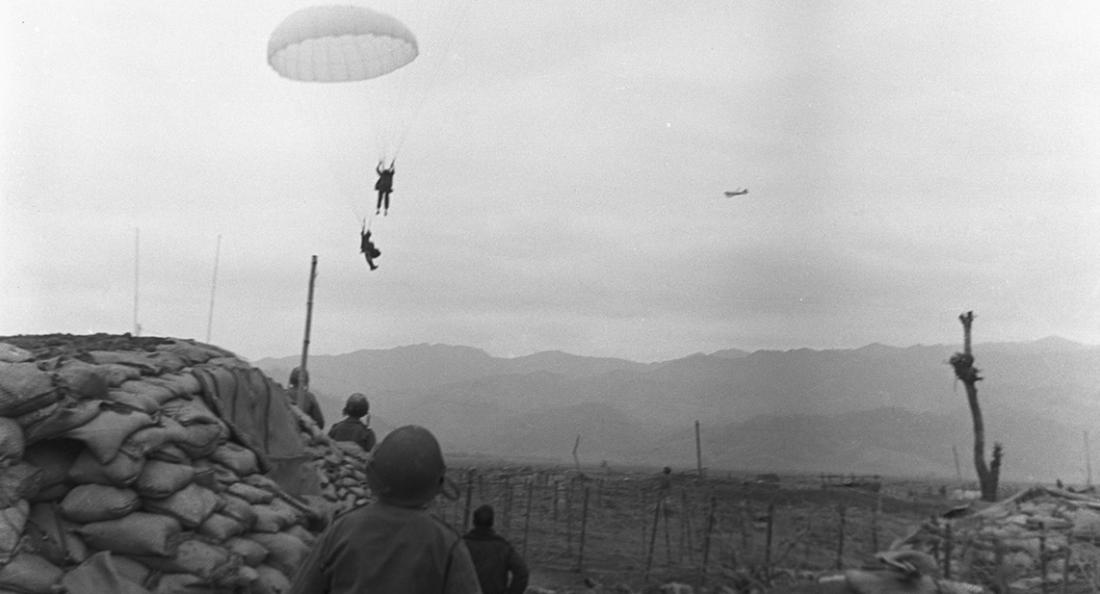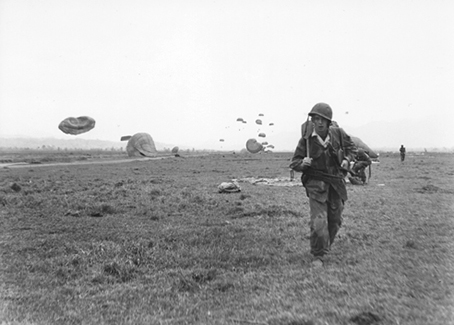Volunteers for Dien Bien Phu

By April 1954, after the series of confrontations of the “Battle of the Five Hills”, the situation of troops in the entrenched camp had deteriorated considerably. By way of reinforcements, non-paratrooper volunteers were dropped on Dien Bien Phu.
On the eve of the Battle of Dien Bien Phu, the garrison of Operational Group Northwest (GONO), commanded by Colonel Christian de la Croix de Castries, consisted of 10 813 soldiers in three sub-sectors and eight centres of resistance comprising ten battalions. A further two battalions were stationed in reserve “in case of setbacks”: the 1st Foreign Parachute Battalion (1st BEP) and the 8th Shock Parachute Battalion (8th BPC).
With the launch of the Viet Minh offensive on 13 March 1954, losses were inflicted on the combat arms capable of standing up to the People’s Army units. In April, Lieutenant-Colonel Langlais, in charge of the counter-attacks at Dien Bien Phu, therefore asked his superiors in Hanoi to authorise non-parachute-trained personnel (i.e. troops who had never before used a parachute) to be parachuted in as reinforcements. Initially, his request was refused, mainly due to opposition from Colonel Sauvagnac, commander of airborne troops in Indochina.
However, in view of the urgency of the situation, on 8 April the general staff of the North Vietnam Ground Forces decided to introduce fast-track courses to qualify non-parachuting volunteers. Yet the first courses would not be held until the 15th. This decision and the command’s slow responses incurred the wrath of Lieutenant-Colonel Langlais who, on 11 April, sent Colonel Sauvagnac his famous telegram: “You still have not understood the situation at Dien Bien Phu – Stop – I repeat, there is no more GONO – or GAP [Airborne Group] – or Legionnaires – or Moroccans, just 3 000 troops the pillars of which are the paras, who are standing up to Giap’s four divisions with unheard-of heroism and sacrifice. The fate of Hanoi and the war in Indochina are being played out at Dien Bien Phu – Stop – You must understand that the battle cannot be fought by parachute troops alone, qualified or otherwise – Stop – Colonel de Castries [...] will obtain from the commanding general anything that you refuse me.”

An order from General Navarre himself was indeed required, authorising volunteers to be dropped on the entrenched camp. In all, of the 4 277 reinforcements sent to aid the garrison between 13 March and 7 May 1954, around 700 were unqualified volunteers. As stated in a report of 15 May, a further 1 100 unqualified volunteers could not be parachuted in due to “inadequate [air] transport in relation to troop numbers”.
After the fall of Dien Bien Phu, General Navarre was criticised for insisting on supplying reinforcements right up to the last days, in view of the shape of the battle. But Navarre believed that his “relentlessness in continuing the resistance”, as he himself described it, was necessary on a number of counts: he was guided by military honour; the possibility of turning the situation around could not be excluded until the last minute; and the chance of a ceasefire before negotiations on Indochina got under way in Geneva prevented him. It is worth highlighting that this policy, which in practice meant the continued supply of reinforcements to the GONO, was not only approved of but ordered by the French government.
Ivan Cadeau - Officer and doctor in history at the Defence Historical Service - in Les Chemins de la Mémoire, no 243, April-May 2014
Interesting fact
Of the 4 277 volunteers parachuted in (1 384 metropolitan French, 30 North Africans, 962 Legionnaires and 1 901 natives), 680 were unqualified (215 metropolitan French, 30 North Africans and 435 Legionnaires)..

